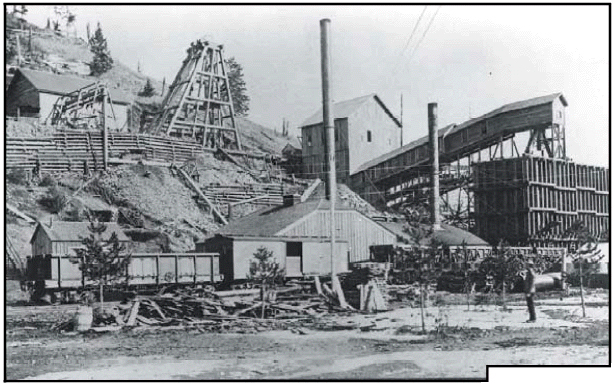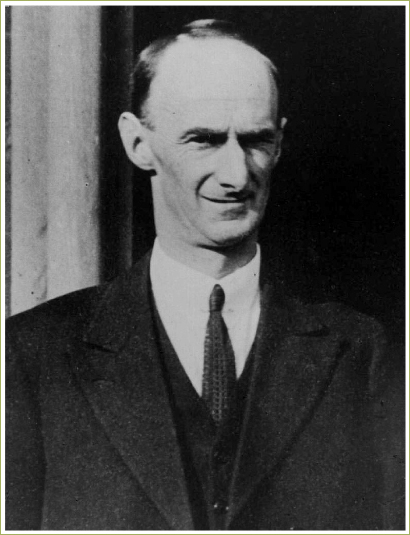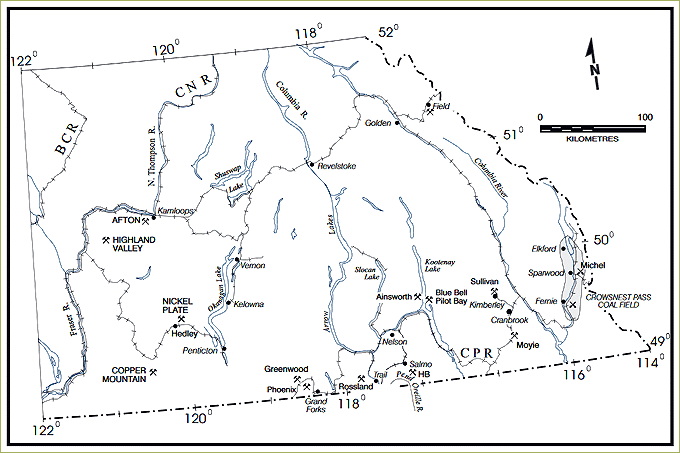

A Provincial Mineralogist's Mining History
BY: BG EDITOR

The Motherlode copper mine at Greenwood in 1898
"Note the well-engineered open shaft, ore bin and railway"
[ Image: BCARS HP 99659 - British Columbia's Geological Surveys, 1895-1995 ]
Mar 07, 2020 — GREENWOOD, BC (BG)
The history of mining in the Boundary region and throughout south-central British Columbia was duly recorded in the British Columbia Geological Surveys, which began publication in 1895. The following excerpts provide a good summary of mining development on the early 19th Century timeline.
"... Lode deposits were being discovered, staked, prospected and developed in many parts of southeastern BC, particularly after 1880: silver and lead at the Bluebell at Kootenay Lake in 1882, gold at Rossland (Centre Star, War Eagle, Le Roi and others) in 1889, silver and lead in the Slocan (Slocan Star, Noble Five, Silver King and others) in 1891 and in the East Kootenays at Moyie Lake (St. Eugene) and Mark Creek (North Star and Sullivan) in 1890 to '92.
Transportation was the main problem inhibiting development as more and more significant prospects were tested from the Rockies (Monarch) to Greenwood (Motherlode, Photo D5). Shipping of small quantities of sacked silver-lead ore by rawhiding in winter to river banks and lakes probably started before 1887 but there is little record. Paddle wheelers were built in the mid 1880s to connect to primitive roads and the railways that followed.
An explosion of activity occurred propelled by the application of American money and the building of railways with the grain of the topography from Spokane. After 1887 silver and lead production increased sharply each year, particularly from Ainsworth in 1889, the Slocan and Moyie in 1892, the Bluebell in 1895 and the Sullivan in 1896. Significant lode gold started to be produced from the Rossland mines in 1893 and copper a year later.
All this development was virtually unaided by Victoria and poorly recorded before the appointment of the Provincial Mineralogist.
Eventually a significant Canadian response occurred with development of the CPR southern line across the trend of the mountain ranges but through the newly discovered Crowsnest coalfield from the Northwest Territories, i.e., now Alberta. Also the Dominion government instituted a bonus for Canadian smelters. This helped initiate the building of short lived plants at Pilot Bay on Kootenay Lake, Revelstoke and Golden but eventually more successful ones at Trail Creek, Grand Forks and Phoenix [referenced photos not included here]. By 1894 the value of minerals shipped from the southeast totaled $781,342 and was increasing sharply every year."
Transportation was the main problem inhibiting development as more and more significant prospects were tested from the Rockies (Monarch) to Greenwood (Motherlode, Photo D5). Shipping of small quantities of sacked silver-lead ore by rawhiding in winter to river banks and lakes probably started before 1887 but there is little record. Paddle wheelers were built in the mid 1880s to connect to primitive roads and the railways that followed.
An explosion of activity occurred propelled by the application of American money and the building of railways with the grain of the topography from Spokane. After 1887 silver and lead production increased sharply each year, particularly from Ainsworth in 1889, the Slocan and Moyie in 1892, the Bluebell in 1895 and the Sullivan in 1896. Significant lode gold started to be produced from the Rossland mines in 1893 and copper a year later.
All this development was virtually unaided by Victoria and poorly recorded before the appointment of the Provincial Mineralogist.
Eventually a significant Canadian response occurred with development of the CPR southern line across the trend of the mountain ranges but through the newly discovered Crowsnest coalfield from the Northwest Territories, i.e., now Alberta. Also the Dominion government instituted a bonus for Canadian smelters. This helped initiate the building of short lived plants at Pilot Bay on Kootenay Lake, Revelstoke and Golden but eventually more successful ones at Trail Creek, Grand Forks and Phoenix [referenced photos not included here]. By 1894 the value of minerals shipped from the southeast totaled $781,342 and was increasing sharply every year."
As noted above, it was not until the B.C. government appointed a Provincial Mineralogist that mining activity here was properly recorded. And it was with the assistance of a Greenwood resident — Mr. John D. Galloway — that some of this important history went down on the record books.
Following is a letter from J. D. Galloway, who served as Provincial Mineralogist in British Columbia for nearly a decade. For some of these years he was a resident of Greenwood, and spent considerable time here executing his duties in the mining industry. This letter, written to his boss, Fleet Robertson, then Provincial Mineralogist, offers an interesting view of various mining interests in the Boundary, circa 1913.
Letter of Information and Progress from J.D. Galloway in the Field
to W. Fleet Robertson, 1913:
The Riverside Hotel
Rock Creek
Oct. 23rd 1913
Wm. Fleet Robertson, Esq.
Victoria, B.C
stamped, Rec'd 27 October 1913]
Dear Sir:-
I arrived back in Greenwood yesterday afternoon from my trip up the West Fork to Beaverdell and Carmi. A wire was waiting for me from Mr. Tolmie [Premier] instructing me to go up the main Kettle River, which followed from the request by Mr. Duncan McIntosh to Mr. Tolmie. The only feasible way to make the trip was to take a team from Greenwood, drive as far as possible and then ride the horses to Copper Creek.
I will be away from 5 to 7 days and should get back to Greenwood about the 30th. I did not receive any word from you at Greenwood and so last night I wired Mr. Tolmie that if the advance I had requested was not already mailed to forward it to Grand Forks. I should be thereabout the 31st and will go from there up the North Fork to Franklin Camp which should take 5 or 6 days.
I received a letter from Wm. E. Scott in regard to a series of pictures depicting the mining industry to be taken be Mr. Gintznich, and also a wire countermanding the instructions on account of unfavorable weather. I sent a wire to Mr. Scott last night telling him of my movements and prophesised good weather for two to three weeks now. The weather has been unusually severe the last 2 weeks but the chances are promising for a good spell now. If the pictures are not taken now there will not be much chance until next summer. Some good pictures could be taken at the Greenwood & Grand Forks smelters, the mines at Phoenix, and perhaps also at Rossland and Trail.
The coal mine at Midway is seriously handicapped by not having any coal, which one must admit is a serious difficulty. As far as I can figure out it is just a stock-jobbing fake. They have a fair amount of black shale which does look sufficiently well to deceive the unwary & sell stock.
I did not go into Camp McKinney as it was covered with snow two weeks ago & will remain covered all Winter. I met the only man who is living there and he assured me it would be a waste of time & money to go in as I could not find out anything. Wallace Mountain at Beaverdell is reviving somewhat and many of the properties there have decided merit. The country is badly broken and in almost every case work has been stopped at some break in the vein. It appears to me the veins are secondarily enriched to a considerable extent between and along the fault planes, and it may be that when the veins are found in place they will be too low grade to be profitably worked. However some properties certainly warrant further exploration.
The Riverside between Rock Creek and Westbridge is a very doubtful proposition. It has been closed for the Winter. Will advise you again on my return to Greenwood.
Respectfully yours,
J.D. Galloway
Rock Creek
Oct. 23rd 1913
Wm. Fleet Robertson, Esq.
Victoria, B.C
stamped, Rec'd 27 October 1913]
Dear Sir:-
I arrived back in Greenwood yesterday afternoon from my trip up the West Fork to Beaverdell and Carmi. A wire was waiting for me from Mr. Tolmie [Premier] instructing me to go up the main Kettle River, which followed from the request by Mr. Duncan McIntosh to Mr. Tolmie. The only feasible way to make the trip was to take a team from Greenwood, drive as far as possible and then ride the horses to Copper Creek.
I will be away from 5 to 7 days and should get back to Greenwood about the 30th. I did not receive any word from you at Greenwood and so last night I wired Mr. Tolmie that if the advance I had requested was not already mailed to forward it to Grand Forks. I should be thereabout the 31st and will go from there up the North Fork to Franklin Camp which should take 5 or 6 days.
I received a letter from Wm. E. Scott in regard to a series of pictures depicting the mining industry to be taken be Mr. Gintznich, and also a wire countermanding the instructions on account of unfavorable weather. I sent a wire to Mr. Scott last night telling him of my movements and prophesised good weather for two to three weeks now. The weather has been unusually severe the last 2 weeks but the chances are promising for a good spell now. If the pictures are not taken now there will not be much chance until next summer. Some good pictures could be taken at the Greenwood & Grand Forks smelters, the mines at Phoenix, and perhaps also at Rossland and Trail.
The coal mine at Midway is seriously handicapped by not having any coal, which one must admit is a serious difficulty. As far as I can figure out it is just a stock-jobbing fake. They have a fair amount of black shale which does look sufficiently well to deceive the unwary & sell stock.
I did not go into Camp McKinney as it was covered with snow two weeks ago & will remain covered all Winter. I met the only man who is living there and he assured me it would be a waste of time & money to go in as I could not find out anything. Wallace Mountain at Beaverdell is reviving somewhat and many of the properties there have decided merit. The country is badly broken and in almost every case work has been stopped at some break in the vein. It appears to me the veins are secondarily enriched to a considerable extent between and along the fault planes, and it may be that when the veins are found in place they will be too low grade to be profitably worked. However some properties certainly warrant further exploration.
The Riverside between Rock Creek and Westbridge is a very doubtful proposition. It has been closed for the Winter. Will advise you again on my return to Greenwood.
Respectfully yours,
J.D. Galloway

John D. Galloway, Provincial Mineralogist
A BRIEF BIOGRAPHY OF JOHN D. GALLOWAY (1889-1942)
Provincial Mineralogist, 1925-1934
"John Davidson Galloway, third Provincial Mineralogist, was born at Napier, New Zealand on October 14, 1889. Early in his life his family settled in Greenwood British Columbia, where he received his primary education. He completed his high school in Vancouver and attended McGill University College there before going to McGill in Montreal. He graduated in 1911 with a B.Sc. and M.E. and first class honours in geology, metallurgy and mining, winning the British Association medal and the Sir William Dawson Fellowship in mining. He received an M.Sc. in 1912.
During his university years he worked as a field assistant with the GSC. After obtaining his masters degree he became assayer and mill manager of the Coronation mine in the Bridge River district for a year. In 1913 Galloway was appointed Assistant Provincial Mineralogist of the British Columbia Department of Mines, however in the reorganization of 1917 he became Resident Engineer for the Northeastern Mineral District in Hazelton.
In 1925 he succeeded Fleet Robertson as Provincial Mineralogist, continuing until he resigned in February, 1934 to become a consultant. During his tenure as Provincial Mineralogist Galloway made a clumsy administrative system work and produced informative Annual Reports until the arrival of the stringency forced by the Great Depression.
When he left the department he managed the Surf Point mine on Porcher Island and later the Kicking Horse and Monarch mines at Field. He was consulting mining engineer for Alaska B.C. Gold Mines when he died.
John Galloway was active in professional affairs with the Canadian Institute of Mining, a Fellow of the Royal Society of Canada and in 1933 was President of the Association of Professional Engineers of British Columbia. He died in Vancouver on February 21, 1942."
FOOTNOTES:
[1] British Columbia's Geological Surveys, 1895-1995: a Century of science and dedication, pp. 41-42, 66, 141-142
http://cmscontent.nrs.gov.bc.ca/geoscience/PublicationCatalogue/Miscellaneous/BCGS_MP-77.pdf



